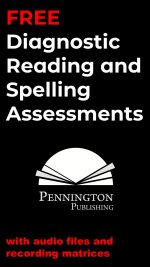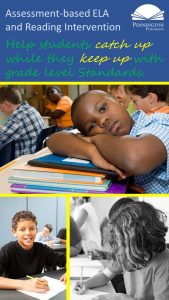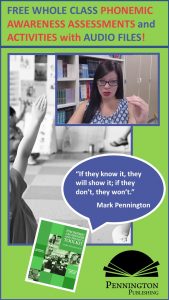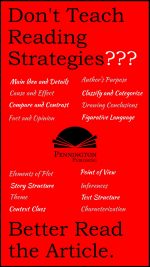FREE Reading and Spelling Assessments
FREE READING AND SPELLING ASSESSMENTS for READING INTERVENTION PROGRAM PLACEMENT and ASSESSMENT-BASED INSTRUCTION
Phonemic Awareness Assessments (Paper Copies)
Use these five phonemic awareness (syllable awareness, syllable rhyming, phonemic isolation, phonemic blending, phonemic segmenting) and two awareness assessments (upper and lower case identification and application) to determine reading readiness. Each of the seven assessments is administered whole class. The author’s Teaching Reading Strategies reading intervention program includes corresponding phonemic awareness and alphabetic awareness activities to remediate all deficits indicated by the assessments.
- Syllable Awareness Assessment (5:48 Audio File)
- Syllable Rhyming Assessment (5:38 Audio File)
- Phonemic Isolation Assessment (5:54 Audio File)
- Phonemic Blending Assessment (5:53 Audio File)
- Phonemic Segmenting Assessment (5:21 Audio File)
Vowel Sounds Phonics Assessment (Paper Copy) *
Use this comprehensive 52 item whole class assessment to determine your students’ mastery of short vowels, long vowels, silent final e, vowel digraphs, vowel diphthongs, and r-controlled vowels. The assessment uses nonsense words to test students’ knowledge of the sound-spellings to isolate the variable of sight word recognition. Unlike other phonics assessments, this assessment is not a random sample of phonics knowledge. The Vowel Sounds Phonics Assessment includes every common sound-spelling. Thus, the results of the assessment permit targeted instruction in any vowel sound phonics deficits. The author’s Teaching Reading Strategies reading intervention program includes corresponding worksheets and small group activities to remediate all deficits indicated by this assessment.
- Vowel Sounds Phonics Assessment (10:42 Audio File)
Consonant Sounds Phonics Assessment (Paper Copy) *
Use this comprehensive 50 item whole class assessment to determine your students’ mastery of consonant digraphs, beginning consonant blends, and ending consonant blends. The assessment uses nonsense words to test students’ knowledge of the sound-spellings to isolate the variable of sight word recognition. Unlike other phonics assessments, this assessment is not a random sample of phonics knowledge. The Consonant Sounds Phonics Assessment includes every common sound-spelling. Thus, the results of the assessment permit targeted instruction in any consonant sound phonics deficits. The author’s Teaching Reading Strategies reading intervention program includes corresponding worksheets and small group activities to remediate all deficits indicated by this assessment.
- Consonant Sounds Phonics Assessment (12:07 Audio File)
Outlaw Words Assessment (Non-Phonetic Sight Words)(Paper Copy)
Use this 99 item whole class assessment to determine your students’ mastery of the most common non-phonetic English words. The author’s Teaching Reading Strategies reading intervention program includes small group activities to remediate all deficits indicated by this 15-minute assessment. The program includes an Outlaw Words fluency article which uses all assessment sight words. The program also provides sight word game card masters and individual sets of business card size game cards in the accompanying Reading and Spelling Game Cards.
Sight Syllables Assessment (Paper Copy)
Use this 49 item whole class assessment to determine your students’ mastery of the most common Greek and Latin prefixes and suffixes. Memorization and practice of these high utility affixes will assist with syllabication, spelling, and vocabulary development. The author’s Teaching Reading Strategies reading intervention program provides Greek and Latin prefix and suffix game card masters and individual sets of business card size game cards in the accompanying Reading and Spelling Game Cards.
The Pets Fluency Assessment (Paper Copy) *
The “Pets” expository fluency passage is leveled in a unique pyramid design: the first paragraph is at the first grade (Fleish-Kincaid) reading level; the second paragraph is at the second grade level; the third paragraph is at the third grade level; the fourth paragraph is at the fourth grade level; the fifth paragraph is at the fifth grade level; the sixth paragraph is at the sixth grade level; and the seventh paragraph is at the seventh grade level. Thus, the reader begins practice at an easier level to build confidence and then moves to more difficult academic language. As the student reads the fluency passage, the teacher will be able to note the reading levels at which the student has a high degree of accuracy and automaticity. Automaticity refers to the ability of the reader to read effortlessly without stumbling or sounding-out words. The 383 word passage permits the teacher to assess two-minute reading fluencies (a much better measurement than a one-minute timing).
Diagnostic Spelling Assessment (Paper Copy) *
Use this comprehensive diagnostic assessment to pinpoint all sound-spelling patterns learned from kindergarten through eighth grade. This 102 item eighth grade test pinpoints spelling deficits and equips the teacher to individualize instruction according to the assessment-data. The author’s Grades 4-8 Differentiated Spelling Instruction programs and the comprehensive Grammar, Mechanics, Spelling, and Vocabulary Grades 4-8 programs provide weekly spelling tests with spelling sorts, plus targeted worksheets to remediate each unknown assessment sound-spelling. Each worksheet includes a spelling sort and formative assessment.
- Diagnostic Spelling Assessment (22:38 Audio File)
- Spelling Patterns Assessment Matrix
* Placement Assessments
*****
You can help turn struggling and vulnerable students into confident and skilled readers with the Teaching Reading Strategies program.
The Teaching Reading Strategies (Reading Intervention Program) is designed for non-readers or below grade level readers ages eight-adult. Ideal as both Tier II or III pull-out or push-in reading intervention for older struggling readers, special education students with auditory processing disorders, and ESL, ESOL, or ELL students. This full-year (or half-year intensive) program provides explicit and systematic whole-class instruction and assessment-based small group workshops to differentiate instruction. Both new and veteran reading teachers will appreciate the four training videos, minimal prep and correction, and user-friendly resources in this program, written by a teacher for teachers and their students.
The program provides 13 diagnostic reading and spelling assessments (many with audio files). Teachers use assessment-based instruction to target the discrete concepts and skills each student needs to master according to the assessment data. Whole class and small group instruction includes the following: phonemic awareness activities, synthetic phonics blending and syllabication practice, phonics workshops with formative assessments, expository comprehension worksheets, 102 spelling pattern assessments, reading strategies worksheets, 123 multi-level fluency passage videos recorded at three different reading speeds, writing skills worksheets, 644 reading, spelling, and vocabulary game cards (includes print-ready and digital display versions) to play entertaining learning games.
In addition to these resources, the program features the popular Sam and Friends Guided Reading Phonics Books. These 54 decodable books (includes print-ready and digital display versions) have been designed for older readers with teenage cartoon characters and plots. Each 8-page book introduces two sight words and reinforces the sound-spellings practiced in that day’s sound-by-sound spelling blending. Plus, each book has two great guided reading activities: a 30-second word fluency to review previously learned sight words and sound-spelling patterns and 5 higher-level comprehension questions. Additionally, each book includes an easy-to-use running record if you choose to assess. Your students will love these fun, heart-warming, and comical stories about the adventures of Sam and his friends: Tom, Kit, and Deb. Oh, and also that crazy dog, Pug. These take-home books are great for independent homework practice.
The Science of Reading Intervention Program
The Science of Reading Intervention Program: Word Recognition includes explicit, scripted instruction and practice with the 5 Daily Google Slide Activities every reading intervention student needs: 1. Phonemic Awareness and Morphology 2. Blending, Segmenting, and Spelling 3. Sounds and Spellings (including handwriting) 4. Heart Words Practice 5. Sam and Friends Phonics Books (decodables). Plus, digital and printable sound wall cards and speech articulation songs. Print versions are available for all activities. First Half of the Year Program (55 minutes-per-day, 18 weeks)
The Science of Reading Intervention Program: Language Comprehension resources are designed for students who have completed the word recognition program or have demonstrated basic mastery of the alphabetic code and can read with some degree of fluency. The program features the 5 Weekly Language Comprehension Activities: 1. Background Knowledge Mentor Texts 2. Academic Language, Greek and Latin Morphology, Figures of Speech, Connotations, Multiple Meaning Words 3. Syntax in Reading 4. Reading Comprehension Strategies 5. Literacy Knowledge (Narrative and Expository). Second Half of the Year Program (30 minutes-per-day, 18 weeks)
The Science of Reading Intervention Program: Assessment-based Instruction provides diagnostically-based “second chance” instructional resources. The program includes 13 comprehensive assessments and matching instructional resources to fill in the yet-to-be-mastered gaps in phonemic awareness, alphabetic awareness, phonics, fluency (with YouTube modeled readings), Heart Words and Phonics Games, spelling patterns, grammar, usage, and mechanics, syllabication and morphology, executive function shills. Second Half of the Year Program (25 minutes-per-day, 18 weeks)
The Science of Reading Intervention Program BUNDLE includes all 3 program components for the comprehensive, state-of-the-art (and science) grades 4-adult full-year program. Scripted, easy-to-teach, no prep, no need for time-consuming (albeit valuable) LETRS training or O-G certification… Learn as you teach and get results NOW for your students. Print to speech with plenty of speech to print instructional components.
Get the SCRIP Comprehension Strategies FREE Resource:













